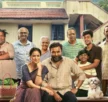

Kadal – Movie Review
- 2nd February 2013
- POST IN :MUSIC
Mani Ratnam’s latest offering is yet another take on the all-too-familiar battle between good and evil. Set in a fishing village off the coast of Tamil Nadu, “Kadal” is a film that is as strong in some aspects as it is weak in others.
There are two main storylines in the film, one being the battle between Father Sam, a Christian priest played by Arvind Swamy, and Bergmans, a smuggler played by Arjun. Next, we have the struggle of a young boy – a son of a prostitute – who tries to find a place for himself amongst the villagers who have shunned him. Eventually, the boy himself is drawn into the battle between priest and smuggler, rocketing from the good side to the dark side in the space of a couple of scenes.
The film opens with Father Sam (Arvind Swamy) and Bergmans (Arjun) locking horns at a seminary, where we are immediately treated to the first of a number of obvious depictions of good versus evil. The result is that Bergmans has to leave, but only after promising to wreak havoc in the priest’s life. Running in parallel with this are some particularly poignant scenes by the sea, where we see a young Thomas. His distress at seeing the way his mother is buried on the shore, and his confusion when he realises that the villagers see him as nothing more than a sin is truly heartbreaking. These scenes are not easy to watch, but are the best in the film by a long shot. Unfortunately, these sparkles of Mani Ratnam’s brilliance in the early part of the film do not crop up too often later on.
Understandably, Thomas grows up to be an angry, lost young man. It is at this point Father Sam moves in to the village church, and begins to set this youngster on the right path. Cue a brief fast-forward, and enter Gautham Karthik as the now adult Thomas. He dabbles in the good at first, and meets the child-like Bea (Thulasi Nair) with whom he falls in love. But his love story takes a brief break while he switches over to the dark side for some time, joining hands with Bergmans. Then, in the flash of an eye, he’s back on the path of redemption with the help of his “angel”, Bea.
Gautham Karthik is impressive in what is a rather challenging role, especially for a debutant; the spectrum of emotions his character deals with are portrayed well. Fifteen-year-old Thulasi Nair’s debut is nowhere nearly as impressive, but it is unclear as to whether this is down to her age, her abilities as an actress, or the fact that her character – though an interesting one – didn’t seem to have been given much chance to develop. Both Arjun and Arvind Swamy played their characters well, but were let down at points by their dialogues.
We saw in Raavanan how Mani Ratnam had made some glaringly obvious references to the Ramayana (e.g. Priyamani and her nose, Karthik swinging from trees), and he hasn’t been any more subtle in his portrayal of good and evil in “Kadal”. The way in which Arjun constantly refers to himself as Satan is tiring, as is the way everyone calls Bea an angel, or child of God. Bea is almost always dressed in white; Arjun in black. The screenplay is rife with references to Satan and Jesus…it’s all just so obvious at points that it’s a wonder they didn’t just stick “Good” and “Evil” labels on their foreheads.
The film lets itself down during the second half, but the camera work and background score are some of its redeeming factors. The art direction and Rajiv Menon’s cinematography are stunning, and some of the scenes are truly breathtaking in terms of setting. AR Rahman’s background score was refreshing, and the soundtrack more eclectic than what we are used to from him. Opening track “Elay Keechan” is a foot-tapping number that has been choreographed and shot well, and the setting for “Moongil Thottam” is beautiful. I’m not sure what I was expecting for the picturisation of the bluesy “Adiye”, but I don’t think anyone was expecting the vibrant, desert-based choreography that we are given. There was a strange silence in the cinema after that song, with a few awkward giggles here and there. Unfortunately, the awkwardness wasn’t restricted to that song alone – the script’s weaker moments did have some members of the audience giggling uncertainly.
“Kadal” held a lot of promise through the early portion, with exquisitely-shot scenes coupled with heart-wrenching moments and some excellent performances. Sadly, this level of beauty isn’t maintained throughout, and I found myself feeling unsatisfied at the way things were wrapped up. Had the dialogues been tighter, and the metaphors been more metaphorical and less literal, “Kadal” could have been a truly brilliant film. It could have been. I still haven’t lost faith in Mani Rathnam, though. 6/10
- Previous Post
Throwback Thursday #14























